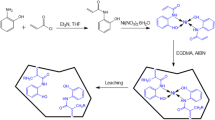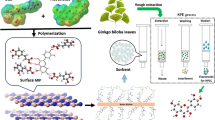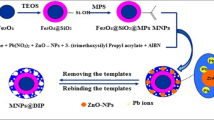ABSTRACT
Molecular imprinting method is widely used to recognize various templates. Recognition of bisphenol A (BPA) as a harmful template is important. Herein a novel BPA molecular imprinted polymer nanoparticles (BMIPN) is reported by core-shell surface molecular imprinting technology. In this process, BPA was imprinted by polymerizing methacrylic acid (MAA) as functional monomer, in presence of ethylene glycol dimethacrylate (EGDMA) as a cross-linker and goethite nanorods (GNR) functionalized with fumaric acid. The formation of different materials in different steps was confirmed by Fourier transform infrared spectroscopy (FT-IR), the size and surface morphological of material was observed by field emission scanning electron microscopy (FESEM) and Transmission electron microscopy (TEM). The BMIPN structure was characterized by X-ray diffraction (XRD) and thermal gravimetric analysis (TGA). The important effective factors on adsorption process such as pH, contact time, amount of GNR, initial concentration of BPA, release and reusability and selectivity of BMIPN were studied. The excellent selectivity behavior of BMIPN was evaluated in the presence of phenol (Ph), 4, 4′-biphenol (BPh), hydroquinone (HQ) and 2, 2′-Bis(4-hydroxyphenyl)butane (BPB), as interferences. Based on the isotherm and kinetic studies, the experimental data obey Langmuir isotherm and the pseudo-second-order kinetic models. The results showed that BMIPN had excellent properties for adsorbing BPA in a short time even in the presence of analogous.







Similar content being viewed by others
References
Huang J, Liu H, Men H, Zhai Y, Xi Q, Zhang Z et al (2013) Molecularly imprinted polymer coating with fluorescence on magnetic particle. Macromol Res 21:1021–1028
Matsumoto K, Tiu BDB, Kawamura A, Advincula RC, Miyata T (2016) QCM sensing of bisphenol A using molecularly imprinted hydrogel/conducting polymer matrix. Polym J 48:525–532
Ragavan K, Rastogi NK (2017) β-Cyclodextrin capped graphene-magnetite nanocomposite for selective adsorption of Bisphenol-A. Carbohydr Polym 168:129–137
Cunha S, Cunha C, Ferreira A, Fernandes J (2012) Determination of bisphenol A and bisphenol B in canned seafood combining QuEChERS extraction with dispersive liquid–liquid microextraction followed by gas chromatography–mass spectrometry. Anal Bioanal Chem 404:2453–2463
Hu X, Wu X, Yang F, Wang Q, He C, Liu S (2016) Novel surface dummy molecularly imprinted silica as sorbent for solid-phase extraction of bisphenol A from water samples. Talanta 148:29–36
Chang T, Yan X, Liu S, Liu Y (2017) Magnetic dummy template silica sol–gel molecularly imprinted polymer nanospheres as magnetic solid-phase extraction material for the selective and sensitive determination of bisphenol A in plastic bottled beverages. Food Anal Methods 10:3980–3990
Zhao W, Sheng N, Zhu R, Wei F, Cai Z, Zhai M et al (2010) Preparation of dummy template imprinted polymers at surface of silica microparticles for the selective extraction of trace bisphenol A from water samples. J Hazard Mater 179:223–229
Steinmetz R, Brown NG, Allen DL, Bigsby RM, Ben-Jonathan N (1997) The environmental estrogen bisphenol A stimulates prolactin release in vitro and in vivo. Endocrinology 138:1780–1786
Watabe Y, Hosoya K, Tanaka N, Kubo T, Kondo T, Morita M (2005) Shielded molecularly imprinted polymers prepared with a selective surface modification. J Polym Sci A Polym Chem 43:2048–2060
Lin Z, Cheng W, Li Y, Liu Z, Chen X, Huang C (2012) A novel superparamagnetic surface molecularly imprinted nanoparticle adopting dummy template: An efficient solid-phase extraction adsorbent for bisphenol A. Anal Chim Acta 720:71–76
Xue J-Q, Li D-W, Qu L-L, Long Y-T (2013) Surface-imprinted core–shell Au nanoparticles for selective detection of bisphenol A based on surface-enhanced Raman scattering. Anal Chim Acta 777:57–62
Deceuninck Y, Bichon E, Marchand P, Boquien C-Y, Legrand A, Boscher C et al (2015) Determination of bisphenol A and related substitutes/analogues in human breast milk using gas chromatography-tandem mass spectrometry. Anal Bioanal Chem 407:2485–2497
Zhang J, Cooke GM, Curran IH, Goodyer CG, Cao X-L (2011) GC–MS analysis of bisphenol A in human placental and fetal liver samples. J Chromatogr B 879:209–214
Navarro-Villoslada F, San Vicente B, Moreno-Bondi MC (2004) Application of multivariate analysis to the screening of molecularly imprinted polymers for bisphenol A. Anal Chim Acta 504:149–162
Sambe H, Hoshina K, Hosoya K, Haginaka J (2006) Simultaneous determination of bisphenol A and its halogenated derivatives in river water by combination of isotope imprinting and liquid chromatography–mass spectrometry. J Chromatogr A 1134:16–23
Hassanzadeh M, Ghaemy M (2017) An effective approach for the laboratory measurement and detection of creatinine by magnetic molecularly imprinted polymer nanoparticles. New J Chem 41:2277–2286
Yang W-l, S-m H, Wu Q-z, He J-f (2014) Properties evaluation and separation application of naringin-imprinted polymers prepared by a covalent imprinting method based on boronate ester. J Polym Res 21:383–390
Zou T, Zhou Z, Dai J, Gao L, Wei X, Li C et al (2014) Preparation of silica-based surface-imprinted core–shell nanoadsorbents for the selective recognition of sulfamethazine via reverse atom transfer radical precipitation polymerization. J Polym Res 21:520–532
Wu Y, Zhuang L, Ma B, Chen S, Xu X, Zeng Y (2014) Preparation of a surface molecularly imprinted fiber for bisphenol a recognition. J Polym Res 21:468–477
Byun H-S, Yang D-S, Cho S-H (2013) Synthesis and characterization of high selective molecularly imprinted polymers for bisphenol A and 2, 4-dichlorophenoxyacetic acid by using supercritical fluid technology. Polymer 54:589–595
Hassanzadeh M, Ghaemy M, Ahmadi S (2016) Extending time profile of morphine-induced analgesia using a chitosan-based molecular imprinted polymer nanogel. Macromol Biosci 16:1515–1523
Huang W, Kong Y, Yang W, Ni X, Wang N, Lu Y et al (2016) Preparation and characterization of novel thermosensitive magnetic molecularly imprinted polymers for selective recognition of norfloxacin. J Polym Res 23:94
Wang H, Ying X, Liu J, Li X, Zhang W (2017) Specific rebinding of protein imprinted polyethylene glycol grafted calcium alginate hydrogel with different crosslinking degree. J Polym Res 24:93–104
Wang Y, Ding Y, Rong F, Fu D (2012) A study of the precipitation polymerization of bisphenol A-imprinted polymer microspheres and their application in solid-phase extraction. Polym Bull 68:1255–1270
Canale F, Cordero C, Baggiani C, Baravalle P, Giovannoli C, Bicchi C (2010) Development of a molecularly imprinted polymer for selective extraction of bisphenol A in water samples. J Sep Sci 33:1644–1651
Zhu R, Zhao W, Zhai M, Wei F, Cai Z, Sheng N et al (2010) Molecularly imprinted layer-coated silica nanoparticles for selective solid-phase extraction of bisphenol A from chemical cleansing and cosmetics samples. Anal Chim Acta 658:209–216
Sanbe H, Haginaka J (2003) Uniformly sized molecularly imprinted polymers for bisphenol A and β-estradiol: retention and molecular recognition properties in hydro-organic mobile phases. J Pharm Biomed Anal 30:1835–1844
Lin Z, He Q, Wang L, Wang X, Dong Q, Huang C (2013) Preparation of magnetic multi-functional molecularly imprinted polymer beads for determining environmental estrogens in water samples. J Hazard Mater 252:57–63
Wang Z, Qiu T, Guo L, Ye J, He L, Li X (2017) The synthesis of hydrophilic molecularly imprinted polymer microspheres and their application for selective removal of bisphenol A from water. React Funct Polym 116:69–76
Zhou H, Xu Y, Tong H, Liu Y, Han F, Yan X et al (2013) Direct synthesis of surface molecularly imprinted polymers based on vinyl–SiO2 nanospheres for recognition of bisphenol A. J Appl Polym Sci 128:3846–3852
Zhang X, Yang S, Zhao W, Liu B, Sun L, Luo A (2015) Surface molecular imprinting on manganese-doped zinc sulfide quantum dots for fluorescence detection of bisphenol A in water. Anal Lett 48:2075–2089
Zhao W-R, Kang T-F, Lu L-P, Shen F-X, Cheng S-Y (2017) A novel electrochemical sensor based on gold nanoparticles and molecularly imprinted polymer with binary functional monomers for sensitive detection of bisphenol A. J Electroanal Chem 786:102–111
Niu M, Pham-Huy C, He H (2016) Core-shell nanoparticles coated with molecularly imprinted polymers: a review. Microchim Acta 183:2677–2695
Guo X, Dong H, Yang C, Zhang Q, Liao C, Zha F et al (2016) Application of goethite modified biochar for tylosin removal from aqueous solution. Colloids Surf A Physicochem Eng Asp 502:81–88
Sun Y, Wang Q, Yang S, Sheng G, Guo Z (2011) Characterization of nano-iron oxyhydroxides and their application in UO22+ removal from aqueous solutions. J Radioanal Nucl Chem 290:643–648
Guo X, Zhang J, Ge J, Yang C, Dang Z, Liu S et al (2015) Sorption and photodegradation of tylosin and sulfamethazine by humic acid-coated goethite. RSC Adv 5:100464–100471
Rose J, Cortalezzi-Fidalgo MM, Moustier S, Magnetto C, Jones CD, Barron AR et al (2002) Synthesis and characterization of carboxylate− FeOOH nanoparticles (ferroxanes) and ferroxane-derived ceramics. Chem Mater 14:621–628
Li H, Li W, Zhang Y, Wang T, Wang B, Xu W et al (2011) Chrysanthemum-like α-FeOOH microspheres produced by a simple green method and their outstanding ability in heavy metal ion removal. J Mater Chem 21:7878–7881
Liu J, Wang W, Xie Y, Huang Y, Liu Y, Liu X, Zhao R, Liu G, Chen Y (2011) A novel polychloromethylstyrene coated superparamagnetic surface molecularly imprinted core–shell nanoparticle for bisphenol A. J Mater Chem 21:9232–9238
Griffete N, Li H, Lamouri A, Redeuilh C, Chen K, Dong C-Z et al (2012) Magnetic nanocrystals coated by molecularly imprinted polymers for the recognition of bisphenol. J Mater Chem 22:1807–1811
Ren Y, Ma W, Ma J, Wen Q, Wang J, Zhao F (2012) Synthesis and properties of bisphenol A molecular imprinted particle for selective recognition of BPA from water. J Colloid Interface Sci 367:355–361
Griffete N, Frederich H, Maître A, Ravaine S, Chehimi M, Mangeney C (2012) Inverse opals of molecularly imprinted hydrogels for the detection of bisphenol A and pH Sensing. Langmuir 28:1005–1012
Duan F, Chen C, Chen L, Sun Y, Wang Y, Yang Y et al (2014) Preparation and evaluation of water-compatible surface molecularly imprinted polymers for selective adsorption of bisphenol A from aqueous solution. Ind Eng Chem Res 53:14291–14300
Author information
Authors and Affiliations
Corresponding author
Rights and permissions
About this article
Cite this article
Amininasab, S.M., Holakooei, P., Shami, Z. et al. Preparation and evaluation of functionalized goethite nanorods coated by molecularly imprinted polymer for selective extraction of bisphenol A in aqueous medium. J Polym Res 25, 84 (2018). https://doi.org/10.1007/s10965-018-1481-y
Received:
Accepted:
Published:
DOI: https://doi.org/10.1007/s10965-018-1481-y




